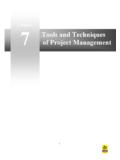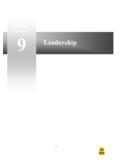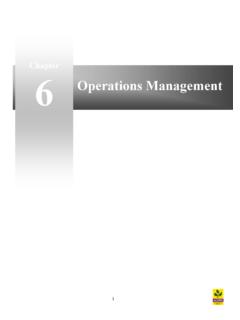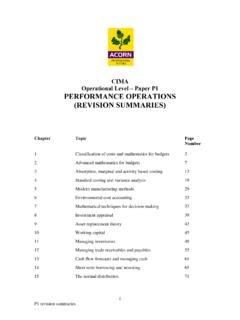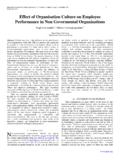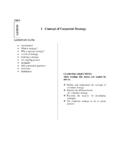Transcription of E3 Enterprise Strategy revision summarise - …
1 E3 revision summaries 1 CIMA Strategic Level Paper E3 Enterprise Strategy ( revision SUMMARIES) Chapter Topic Page Number 1 Strategic Management 3 2 Mission, Objectives and Stakeholders 11 3 Environmental Analysis 15 4 The Position Audit and Corporate Appraisal 19 5 Strategic options 25 6 Marketing 33 7 Information Strategy 45 8 Corporate Social Responsibility and Ethics 61 9 Organisations 67 10 Change Management 73 11 Strategic Performance Measurement 85 12 Numerical skills for strategic evaluation 103 E3
2 revision summaries 2 E3 revision summaries 3 Strategic Management Chapter 1 E3 revision summaries 4 Key summary of chapter What is Strategy ? Strategy A course of action, including the specification of resources required, to achieve a specific objective.
3 CIMA: Official Terminology Levels of Strategy - Johnson and Scholes Arguments in favour of a strategic approach Strategy helps minimise risk Avoids short-term behaviour Improves stakeholder perceptions Encourages environmental analysis critical to react to change Evidence indicates performance can be improved using strategic approaches Integration and coordination of activities and processes Arguments against a strategic approach Difficult to plan when environment changing.
4 Uncertain or complex Encourages conformity stifling innovation the corporate straightjacket Infrequently reviewed chosen long-term Strategy may not keep pace with change Implementation often managed poorly Rational planning a complex methodology and costly for small businesses Functional Strategy (Who) Business Strategy (How) Corporate Strategy (Where) E3 revision summaries 5 Comparing and contrasting approaches to strategic formulation The Rational Planning process Incremental approaches Freewheeling Opportunism Emergent strategies Top-down and centralised Top-down and centralised Top-down and centralised Bottom-up and decentralised Time horizon 2-10 years Time horizon 6 months to 2 years Time horizon day to day basis Time horizon indefinite Formal planning Less formal planning
5 Informal planning Informal planning Complex and costly Less complex and costly Less complex and costly More complex and less costly Stable and certain environment. Dynamic and uncertain environment. Dynamic and uncertain environment. Dynamic and uncertain environment. Inflexible. Flexible. Flexible. Flexible. E3 revision summaries 6 The rational planning process Top-down (centralised) and formalised approach to strategic planning.
6 Originated from the USA the planning horizon for the organisation could be over 2-10 years. Advantages For transformational or radical change Copes with the uncertain future by providing long-term plans Helps integrate and coordinate complex organisations Disadvantages Rational planning can be too rigid and bureaucratic no use for the small business Rational planning can stifle innovation locked into plans No use for dynamic or uncertain environments plans quickly become out of date The rational planning process
7 MISSION & OBJECTIVES ENVIRONMENTAL ANALYSIS POSITION AUDIT CORPORATE APPRAISAL OPTION GENERATION EVALUATION & CHOICE IMPLEMENTATION REVIEW & CONTROL E3 revision summaries 7 Incremental planning approaches (logical incrementalism) Top-down (centralised) and less formalised approach to strategic planning. Smaller, gradual and more incremental adjustments to strategic plans every 6 months up to 2 years maximum. Advantages Less complex and long winded Better for uncertainty or rapidly changing environments More frequent gradual adjustment easier to control and manage Greater frequency of planning to adjust plans to environmental change Disadvantages Too reactive, muddling through Not suitable for transformational or radical change Lack of long-term direction strategic drift may occur The entrepreneurial model (or freewheeling opportunism)
8 Henry Mintzberg referred to freewheeling opportunism as an opportunistic Strategy , dominated by the search for new opportunities, with bold and often high risk decisions that need to be made by the entrepreneur him or herself. Freewheeling opportunism is a top-down (centralised), informal and short-term approach to strategic planning. Advantages Focus on exploiting product and market opportunities never miss a good opportunity Less time consuming and complicated Greater frequency of planning to adjust plans to environmental change Better for uncertainty or rapidly changing environments Disadvantages Organisation too reactive, muddling through Not suitable for transformational or radical change Lack of long-term direction.
9 Relies heavily of the judgement and experience of the founder one single individual E3 revision summaries 8 Emergent strategies Henry Minzberg, described emergent strategies as patterns or consistencies realised despite or in the absence of conscious intention by senior management . Strategy emerges and is unanticipated . Informal and bottom-up (decentralised approach) allowing strategic courses of action to be developed from both tactical and operational levels within the organisation.
10 Advantages Quicker change or repositioning for the organisation lower strategic levels closer to the customer Tactical and operational levels an extensive source of innovative ideas Greater motivation to other strategic levels Supports culture of flexibility, learning and Enterprise Disadvantages Chaotic organisation that lacks control over planning Lack of long-term direction. Organisation too reactive, muddling through Requires entrepreneurial skills from staff which may not exist Comparing and contrasting RBV to the Positioning Approach Resource Based View (RBV) Positioning View (PA) Similarities Both ideas stem from the rational planning process.
